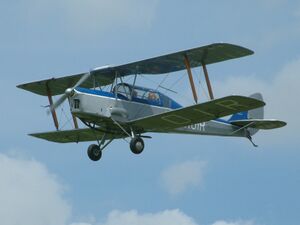Engineering:Thruxton Jackaroo
| Jackaroo | |
|---|---|

| |
| Role | Cabin Tourer |
| Manufacturer | Jackaroo Aircraft Limited |
| First flight | 1957 |
| Primary user | Wiltshire School of Flying |
| Number built | 19 conversions |
| Developed from | de Havilland Tiger Moth |


The Thruxton Jackaroo was a 1950s United Kingdom four-seat cabin biplane converted from a de Havilland Tiger Moth by Jackaroo Aircraft Limited at Thruxton Aerodrome and Rollason Aircraft and Engines Limited at Croydon Airport.
History
The Thruxton Jackaroo was designed as a four-seat cabin general purpose biplane, the original tandem two-seat Tiger Moth fuselage was widened to allow side-by-side seating for 4 people.[1] It was marketed as "the cheapest four-seat aircraft in the world".[2] The first conversion first flew on 2 March 1957.[3] Eighteen Tiger Moths were converted by Jackaroo Aircraft Limited between 1957 and 1959 and one aircraft was converted by Rollason's in 1960.[1] The aircraft could be fitted with an optional crop spraying gear.[4] One converted aircraft was further modified as a single-seat agricultural aircraft, but with little interest in the variant the aircraft was converted back to a Mk. 1.[1]
Variants

- Jackaroo Mk 1
- Production cabin biplane with wooden canopy.[1]
- Jackaroo Mk 2
- Single-seat Agricultural variant with either a hopper or 60-gal tank in place of the two front seats, one conversion.[1][2]
- Jackaroo Mk 3
- Production cabin biplane with metal canopy and provision for brakes.[1]
Specifications
Data from De Havilland Aircraft since 1909[5]
General characteristics
- Crew: 1
- Capacity: 3 passengers
- Length: 25 ft 0 in (7.62 m)
- Wingspan: 30 ft 4 1⁄4 in (9.252 m)
- Height: 9 ft 6 in (2.90 m)
- Wing area: 239 sq ft (22.2 m2)
- Empty weight: 1,360 lb (617 kg)
- Max takeoff weight: 2,180 lb (989 kg)
- Powerplant: 1 × de Havilland Gipsy Major 4-cylinder air-cooled inverted in-line piston engine, 130 hp (97 kW)
- Propellers: 2-bladed fixed-pitch propeller
Performance
- Maximum speed: 102 mph (164 km/h, 89 kn)
- Cruise speed: 90 mph (140 km/h, 78 kn)
- Range: 250 mi (400 km, 220 nmi)
- Rate of climb: 600 ft/min (3.0 m/s)
See also
Related development
References
- ↑ 1.0 1.1 1.2 1.3 1.4 1.5 Jackson 1987, pp. 309-311
- ↑ 2.0 2.1 "Thruxton Jackaroo". Flight: 327. 29 August 1958. https://www.flightglobal.com/pdfarchive/view/1958/1958-1-%20-%200323.html.
- ↑ Bridgman 1958, p. 92.
- ↑ "Handling the Thruxton Jackaroo". Flight: 44. 12 July 1957. https://www.flightglobal.com/pdfarchive/view/1957/1957%20-%200944.html.
- ↑ Jackson 1987, p. 311.
- Bridgman, Leonard (1958). Jane's All the World's Aircraft 1958–59. London: Sampson Low, Marston & Company, Ltd..
- Jackson, A.J. (1987). De Havilland Aircraft since 1909 (3rd ed.). London: Putnam. ISBN 0-85177-802-X.
 |
